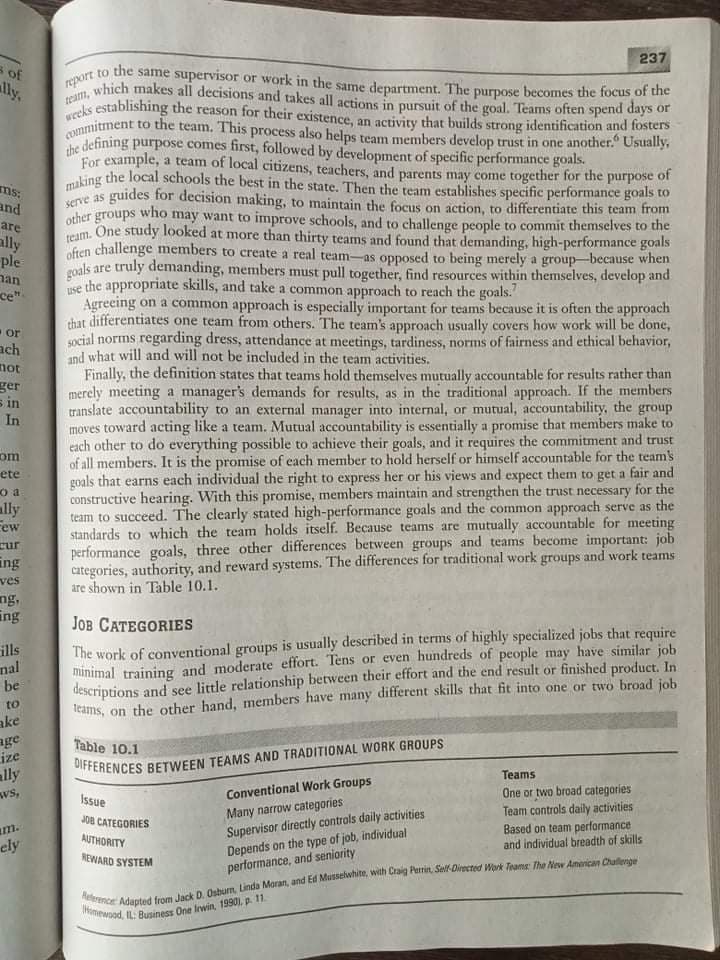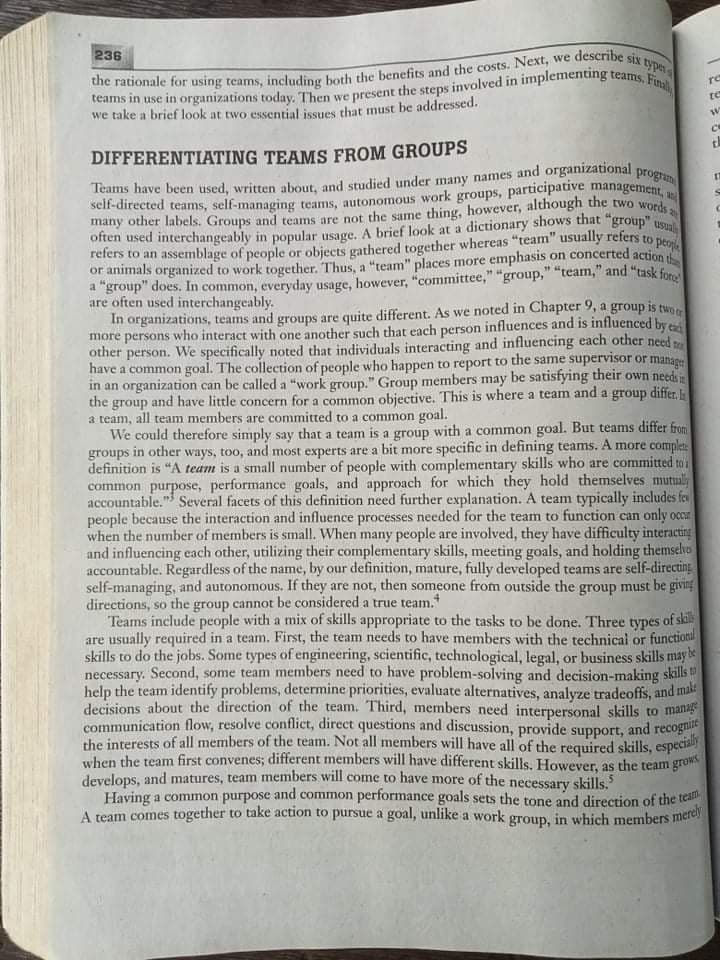are groups the same with teams or are two different? how did you say so? explain in essay for
are groups the same with teams or are two different? how did you say so? explain in essay for
Management, Loose-Leaf Version
13th Edition
ISBN:9781305969308
Author:Richard L. Daft
Publisher:Richard L. Daft
Chapter18: Leading Teams
Section: Chapter Questions
Problem 5DQ
Related questions
Question
are groups the same with teams or are two different? how did you say so? explain in essay form

Transcribed Image Text:report to the same supervisor or work in the same department. The purpose becomes the focus of the
weeks establishing the reason for their existence, an activity that builds strong identification and fosters
237
s of
lly,
team,
which makes all decisions and takes all actions in pursuit of the goal. Teams often spend days or
Commitment
to the team. T his process also helps team members develop trust in one another." Usualy,
making
guides for decision making, to maintain the focus on action, to differentiate this team from
defining purpose comes first, followed by development of specific performance goals.
For example, a team of local citizens, teachers, and parents may come together for the purpose o
the local schools the best in the state. Then the team establishes specific performance goals to
ms:
and
serve as
groups who
One study looked at more than thirty teams and found that demanding, high-performance goals
other
may want to improve schools, and to challenge people to commit themselves to the
are
ally
ple
nan
ce"
team.
often challenge members to create a real team-as opposed to being merely a group-because when
goals are
ise the appropriate skills, and take a common approach to reach the goals."
Agrecing on a common approach is especially important for teams because it is often the approach
that differentiates one team from others. The team's approach usually covers how work will be done,
social norms regarding dress, attendance at meetings, tardiness, norms of fairness and ethical behavior,
nd what will and will not be included in the team activities.
Finally, the definition states that teams hold themselves mutually accountable for results rather than
merely meeting a manager's demands for results, as in the traditional approach. If the members
translate accountability to an external manager into internal, or mutual, accountability, the group
moves toward acting like a team. Mutual accountability is essentially a promise that members make to
each other to do everything possible to achieve their goals, and it requires the commitment and trust
of all members. It is the promise of each member to hold herself or himself accountable for the team's
goals that earns each individual the right to express her or his views and expect them to get a fair and
constructive hearing. With this promise, members maintain and strengthen the trust necessary for the
team to succeed. The clearly stated high-performance goals and the common approach serve as the
standards to which the team holds itself. Because teams are mutually accountable for meeting
performance goals, three other differences between groups and teams become important: job
categories, authority, and reward systems. The differences for traditional work groups and work teams
are shown in Table 10.1.
truly demanding, members must pull together, find resources within themselves, develop and
or
ach
not
ger
s in
In
om
ete
o a
ally
Few
cur
ing
ves
ng,
ing
JOB CATEGORIES
ills
nal
be
The work of conventional groups is usually described in terms of highly specialized jobs that require
minimal training and moderate effort. Tens or even hundreds of people may have similar job
descriptions and see little relationship between their effort and the end result or finished product. In
teams, on the other hand, members have many different skills that fit into one or two broad job
to
ake
age
ize
ally
ws,
Table 10.1
DIFFERENCES BETWEEN TEAMS AND TRADITIONAL WORK GROUPS
Teams
Issue
Conventional Work Groups
Many narrow categories
Supervisor directly controls daily activities
Depends on the type of job, individual
performance, and seniority
One or two broad categories
Team controls daily activities
Based on team performance
and individual breadth of skills
JOB CATEGORIES
am.
ely
AUTHORITY
REWARD SYSTEM

Transcribed Image Text:refers to an assemblage of people or objects gathered together whereas "team" usually refers to peoi
the interests of all members of the team. Not all members will have all of the required skills, especialy
e describe six type
236
re
te
we take a brief look at two essential issues that must be addressed.
DIFFERENTIATING TEAMS FROM GROUPS
program
Teams have been used, written about, and studied under many names and organızational
many other labels. Groups and teams are not the same thing, however, althougn the two words
or animals organized to work together. Thus, a "team" places more emphasis on concerted action
a "group" does. In common, everyday usage, however, "committee," "group," "team," and "task foro
are often used interchangeably.
In organizations, teams and groups are quite different. As we noted in Chapter 9, a group is two
more persons who interact with one another such that each person influences and is influenced bye
other person. We specifically noted that individuals interacting and influencing each other need
have a common goal. The collection of people who happen to report to the same supervisor or manage
in an organization can be called a "work group." Group members may be satisfying their own needs
the group and have little concern for a common objective. This is where a team and a group differ,
a team, all team members are committed to a common goal.
We could therefore simply say that a team is a group with a common goal. But teams differ from
groups in other ways, too, and most experts are a bit more specific in defining teams. A more complet
definition is "A team is a small number of people with complementary skills who are committed to a
common purpose, performance goals, and approach for which they hold themselves mutuly
accountable." Several facets of this definition need further explanation. A team typically includes fev
people because the interaction and influence processes needed for the team to function can only occu
when the number of members is small. When many people are involved, they have difficulty interacting
and influencing each other, utilizing their complementary skills, meeting goals, and holding themselve
accountable. Regardless of the name, by our definition, mature, fully developed teams are self-directing
self-managing, and autonomous. If they are not, then someone from outside the group must be giving
directions, so the group cannot be considered a true team.
Teams include pcople with a mix of skills appropriate to the tasks to be done. Three types of skil
are usually required in a team. First, the team needs to have members with the technical or functionil
skills to do the jobs. Some types of engineering, scientific, technological, legal, or business skills may e
necessary. Second, some team members need to have problem-solving and decision-making skills t
help the team identify problems, determine priorities, evaluate alternatives, analyze tradeoffs, and mai
decisions about the direction of the team. Third, members need interpersonal skills to manag
communication flow, resolve conflict, direct questions and discussion, provide support, and recogni
when the team first convenes; different members will have different skills. However, as the team grow
develops, and matures, team members will come to have more of the necessary skills.
Having a common purpose and common performance goals sets the tone and direction of the tean
A team comes together to take action to pursue a goal, unlike a work group, in which members mere
Expert Solution
This question has been solved!
Explore an expertly crafted, step-by-step solution for a thorough understanding of key concepts.
Step by step
Solved in 2 steps

Recommended textbooks for you

Management, Loose-Leaf Version
Management
ISBN:
9781305969308
Author:
Richard L. Daft
Publisher:
South-Western College Pub

Management, Loose-Leaf Version
Management
ISBN:
9781305969308
Author:
Richard L. Daft
Publisher:
South-Western College Pub